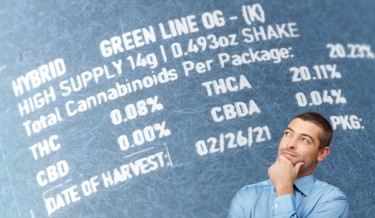
Over the past few years, the cannabis market in the United States has skyrocketed. You may now choose from hundreds of marijuana products because marijuana is now legal in many jurisdictions and because demand is growing. Each time you visit a dispensary, edibles, THC oil, and CBD Concentrates, pills, and ointments are all around you. Knowing how to read product labels and comprehend THC levels will help you feel more at ease.
Have you ever experienced information overload when reading cannabis labels such as THC vs.TAC? After all, there are numerous abbreviations, percentages, and ingesting techniques to learn about, and initially, it may seem difficult to choose the proper product. However, if you brush up on your basic cannabis knowledge, you'll understand everything the label on your product implies.
The TAC number may be the most significant element on a cannabis label, even if THC and CBD are the two cannabinoids that are maybe best known. What does TAC stand for specifically, and why is it important? Does TAC make you higher, too?
WHAT IS TAC
Total Active Cannabinoids, or TAC, is the term used to describe the number of active cannabinoids found in cannabis when it was analyzed in a laboratory. Cannabis contains a range of active compounds, in contrast to medicines, which frequently only have one active ingredient.
Over 400 chemicals, including more than 100 cannabinoids, are thought to be present in marijuana (hemp and cannabis). They can generally be divided into the following categories: Cannabinoids, Terpenoids, Flavonoids, Alkaloids, and Glycoproteins.
TAC, an indicator of the quantity of all cannabinoids that make up a cannabis product, is used to gauge its potency. Consider the following important cannabinoids:
Tetrahydrocannabinol (THC)
THC, often known as tetrahydrocannabinol, is the primary ingredient in marijuana. In its active condition, it is known scientifically as delta-9-tetrahydrocannabinol or delta-9-THC. Additionally, this results in the ecstasy or "high" related to marijuana use. It is generally accepted that a high created by high levels of THC will be stronger than one produced by low levels of the active component.
In addition to THC, CBD is probably the cannabinoid that has the greatest popularity and demand. CBD may provide a number of health advantages, including the reduction of stress and inflammation. All CBD in your product is included in the TAC. Most significantly, unlike THC, CBD does not cause intoxication.
Commonly referred to as the "sleep" cannabinoid is the CBN. CBN is a non-intoxicating substance with a wide spectrum of medicinal effects. Early studies suggest that cannabinol may improve sleep and lessen pain.
Similar to how CBD might lessen THC's euphoric effects, CBG has no intoxicating properties. Cannabis users can do this to take advantage of THC's advantages without experiencing strong highs.
This actiothe endocannabinoid system may mediate this effectmay also be brought on by CBG's effects on alpha-2 adrenergic receptors, which reduce the activity of the sympathetic nervous system.
Although this substance has been known for 50 years, its benefits are still unknown. The fact that CBC comes from cannabigerolic acids (CBGA), like THC and CBD, is recognized. However, how the less popular cannabinoids impact human biology is not well understood.
Inexperienced professionals frequently mispronounce TAC as Total Aerobic Count. The difference between it and Total Active Cannabinoids is that it alludes to a distinct element of the plant's makeup. You can determine the number of microorganisms in the cannabis sample by calculating the total aerobic count.
THE DIFFERENCES BETWEEN THC AND TAC
As suggested by its name, TAC describes the chemical makeup of any cannabis or hemp plant by supplying a list of the cannabinoids that are active in the plant. The product's total cannabis content is therefore represented by TAC. TAC considers the full range of active cannabinoids present in the product, which is quite different from THC, which is merely one cannabinoid.
RELATIONSHIP BETWEEN THC AND TAC
Between TAC and THC components, there is a substantial interaction. For instance, CBD may lessen anxiety brought on by THC, so changing the psychoactive effect as a whole.
Additionally, it is important to remember that some TAC cannabinoids, such as CBGA, aid in the synthesis of THC. Acidic CBGA, a kind of CBG, disintegrates into CBG and then disintegrates even more into other cannabinoids, like THC.
HOW THC INFLUENCES THE ENTOURAGE EFFECT
The synergistic interplay of terpenes, cannabinoids, and flavonoids in cannabis is theoretically referred to as the entourage effect. Phytocannabinoids and terpenes, among other elements of the cannabis plant, are said to boost the effects of one another.
Regarding the entourage effect, the TAC is crucial. Nevertheless, fatty acids, flavonoids, and terpenes are additional significant chemicals that exist in addition to cannabinoids. Furthermore, the entourage effect depends on all of the other compounds, even if the bulk of them are insufficiently understood.
Terpenes, which are found in cannabis, give each strain its own distinct flavor. Terpenes are produced by all plants, fruits, and flowers, not just cannabis crops; they are a natural component of all plant life. The terpenes limonene, linalool, pinene, and eucalyptol are some of the more popular ones. Terpenes may also have psychotropic effects, which explains why some terpenes have sedative properties.
But plant pigments come from flavonoids, which are notable for being powerful antioxidants. Along with this, it is still necessary to investigate the process by which they add to the entourage effect.
BOTTOM LINE
TAC and THC are being contrasted in order to see which is more advantageous or "greater" in terms of potency or purity. Instead, it indicates that you should definitely consider the percentage of TAC in addition to the THC when choosing a cannabis product, whether it is intended for medical usage or for recreational usage, so as to make a knowledgeable choice. A more thorough picture of the full cannabis product is provided by the TAC percentage. But if strength is your first priority, you might want to opt for a product with a higher THC content. Of course, it is crucial to keep in mind that every individual responds to cannabis differently, so start with a modest dose and gradually raise it as necessary.







